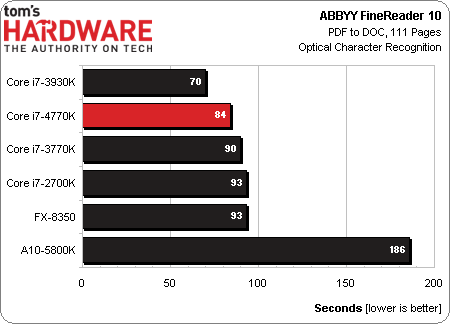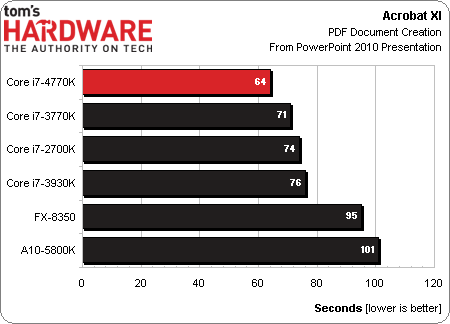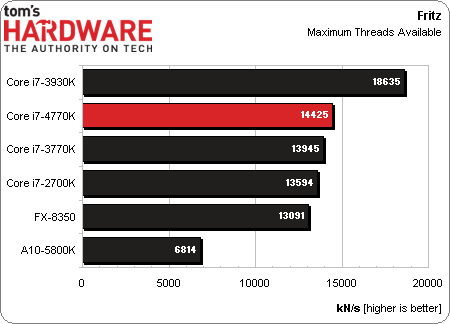The Core i7-4770K Review: Haswell Is Faster; Desktop Enthusiasts Yawn
Intel's Haswell architecture is finally available in the flagship Core i7-4770K processor. Designed to drop into an LGA 1150 interface, does this new quad-core CPU warrant a complete platform replacement, or is your older Sandy Bridge-E system better?
Results: Productivity
Three generations of Intel CPUS are separated by roughly 10 percentage points, with AMD’s FX-8350 tying the Core i7-2700K at the slower end of that range. Given its ability to scale across at least 12 threads, FineReader puts Intel’s Core i7-3930K in first place.
In sharp contrast, printing a PowerPoint presentation to PDF only involves a single thread. So, the CPU with the highest clock rate and best IPC wins. That processor is Intel’s new Core i7-4770K, which outperforms the Core i7-3770K that, in turn, out-maneuvers the Core i7-2700K.
This is where AMD’s Piledriver architecture especially feels pain. Despite throttling up under the effects of Turbo Core technology, the FX-8350 and A10-5800K fall quite a bit behind.
Prior compile projects wrapped up a lot faster. So, you asked us for something more demanding. This Google Chrome workload is well-threaded, which is why the Core i7-3930K places first. Intel’s new Core i7-4770K isn’t far behind, though. Meanwhile, Core i7-3770K and -2700K maintain a sizeable advantage over AMD’s quad-module FX-8350.
Fritz isn’t really a productivity app (unless you consider playing chess productive), but we’re putting it here anyway. The results from each processor are reflected in kilonodes per second. A node is a position on the chessboard. So, in the case of Core i7-4770K, Fritz evaluates more than 14,000 thousand nodes per second, or 14+ million. If you give the engine enough time to “think”, you’re going to get a pretty competitive computer opponent. Hope you brought your A-game.
Get Tom's Hardware's best news and in-depth reviews, straight to your inbox.
Current page: Results: Productivity
Prev Page Results: Content Creation Next Page Results: Compression Apps-
Danny N Biggest question is if its worth upgrading my cpu i5 750 4.0ghz to Haswell or my gfx card ati 5870 to nvidia 7xx, my main pc use is for Maya, After FX and some fps gaming. Any input would be appriciated cause I'm leaning towards a cpu upgrade atm.Reply -
refillable @Danny NReply
You shouldn't ask here. Perhaps you should get an i7-4770k and a 7970(?) I heard that kepler cards does not perform that good in Maya and Aftereffects (In OpenCL). -
envy14tpe Seriously. What did people expect? Of course it's better but nothing out of the ordinary for Intel.Reply -
enewmen For me it's not about the 10% gain over SB. It's more like a huge gain over a C2Q, floating point performance over SB (should matter later), and lower watts. I hope THG can expand the Power Consumption and Media Encoding later - check the Watts idle more and fast quick-sync media encoding quality loss. My 2 cents..Reply
EDIT:
other sites have reported much lower watts idle, so a lot doesn't make sense or the 4770k has a very slow throttle.
http://hexus.net/tech/reviews/cpu/56005-intel-core-i7-4770k-22nm-haswell/?page=15
http://www.techspot.com/review/679-intel-haswell-core-i7-4770k/page13.html




